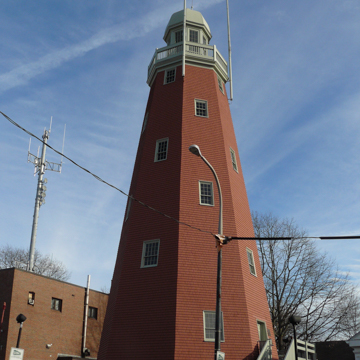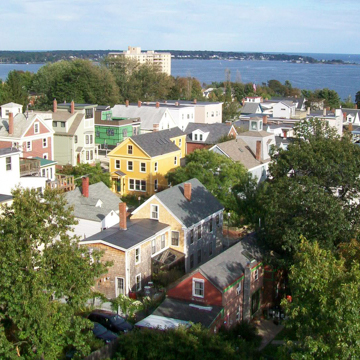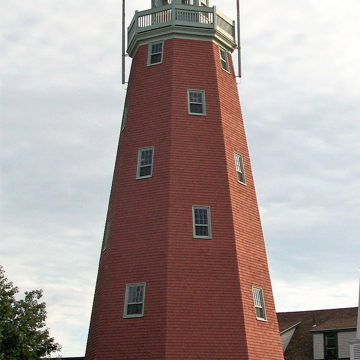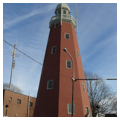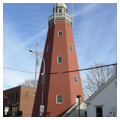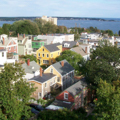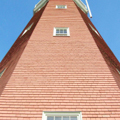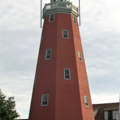The Portland Observatory sits in its original location on Congress Street on Munjoy Hill. The maritime signal tower is a beacon underscoring the city’s once dominant maritime heritage. The Observatory was constructed in 1807 by Captain Lemuel Moody on what was originally pasture land. It was used as a signal tower from 1807 to 1923, and is the only remaining maritime signal station in the United States. Shipping merchants purchased the right to have their flag stored in the signal station and hoisted whenever their merchant vessel was reported approaching, a vital means of communication before the radio. The signal station helped make antebellum Portland a successful entrepôt and shipbuilding center.
The seven-story Observatory stands 86 feet tall and is built of wood and stone. Octagonal in plan, the structure is 32 feet diameter at its base and narrows to only 8 feet diameter at the top. The foundation consists of 122 tons of stone rubble mortared together to rest on foundation beams; there is no basement. The tower’s post-and-beam construction is of eastern white pine. There are three layers to the structure including the timber frame, sheathing, and exterior shingles. Timbers of varying sizes comprise the frame of the building. The eight main vertical timbers stand approximately 65 feet tall. The floor plates are created by parallel beams that rotate on each consecutive level. Each floor is strengthened by diagonal bracing and sheathing boards, which are laid horizontally across the frame and are attached to the shingles. The height from floor to ceiling varies at different levels and becomes shorter on the higher levels until it reaches the peak.
The tower is entered via the first level stairs and entrance deck, and stairs along the interior wall of the tower lead into the lantern level, where an observatory platform lies. The observation room once included an achromatic refracting telescope able to spot ships 30 miles out to sea. Originally, the tower had 33 windows, with four on each floor having varied frames: the first- and second-story windows are twelve-over-eight lights, the third- and fourth-story windows are nine-over-six, and the fifth- and sixth-story windows are six-over-six. The structure has been referred to as the “Brown Tower,” since the original pine shingles were a reddish brown color.
The Moody family continued to operate the Observatory until 1923, when two-way radio communication rendered it obsolete. After falling into disrepair, the tower was donated to the City of Portland. In 1939 the Works Progress Administration completed the first of several restorations. A center column was added to the structure at this time, as well as several new windows. During a 1976 restoration, a new railing and walkway were added. The foundation timbers and shingles were replaced in 1983, with the new western red cedar shingles stained to match the tower’s original color. The deck was also reconstructed and extended along the entire building. The most ambitious restoration effort occurred in 1998–2000, when a beetle infestation threatened the structure’s integrity. Fourteen percent of the timber boards were replaced, although they were left unstained to distinguish them from the original boards. New shingles were attached to wooden strapping, which was, in turn, attached to sheathing to allow for increased airflow and decreased moisture. The original lantern and flag poles remain mostly unaltered.
In 1984 the non-profit organization Greater Portland Landmarks secured management of the tower, opening it for tours. Today, the Observatory remains an important testament to the nautical history of Portland, even if it is no longer active as a signal tower.
References
Calhoun, Charles. “Longfellow’s Portland.” In Creating Portland: History and Place in Northern New England, edited by Joseph A. Conforti .Durham: University of New Hampshire, 2005.
Greater Portland Landmarks. Portland.Portland, ME: Greater Portland Landmarks, 1972.
“Portland Observatory,” Cumberland County, Maine. National Historic Landmark Nomination, 1973. National Park Service, U.S. Department of the Interior, Washington, DC.














